
The Umayyad Caliphate or Umayyad Empire was the second caliphate established after the death of the Islamic prophet Muhammad and was ruled by the Umayyad dynasty. Uthman ibn Affan, the third of the Rashidun caliphs, was also a member of the clan. The family established dynastic, hereditary rule with Mu'awiya I, the long-time governor of Greater Syria, who became caliph after the end of the First Fitna in 661. After Mu'awiya's death in 680, conflicts over the succession resulted in the Second Fitna, and power eventually fell to Marwan I, from another branch of the clan. Syria remained the Umayyads' main power base thereafter, with Damascus as their capital.

Mu'awiya I was the founder and first caliph of the Umayyad Caliphate, ruling from 661 until his death. He became caliph less than thirty years after the death of the Islamic prophet Muhammad and immediately after the four Rashidun ('rightly-guided') caliphs. Unlike his predecessors, who had been close, early companions of Muhammad, Mu'awiya was a relatively late follower of Muhammad.

Ali ibn Abi Talib was the cousin and son-in-law of the Islamic prophet Muhammad, and was the fourth Rashidun caliph who ruled from 656 to 661, as well as the first Shia imam. Born to Abu Talib ibn Abd al-Muttalib and Fatima bint Asad, a young Ali was raised by his elder cousin Muhammad and was among the first to accept his teachings.

Hasan ibn Ali was an Alid political and religious leader. The eldest son of Ali and Fatima and a grandson of the Islamic prophet Muhammad, Hasan briefly ruled as caliph from January 661 until August 661. He is considered as the second Imam in Shia Islam, succeeding Ali and preceding his brother Husayn. As a grandson of the prophet, he is part of the ahl al-bayt and the ahl al-kisa, and also participated in the event of mubahala.
Banu Abd Shams refers to a clan within the Meccan tribe of Quraysh.
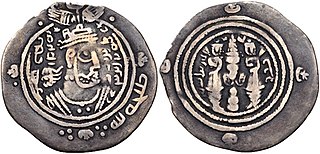
Marwan ibn al-Hakam ibn Abi al-As ibn Umayya, commonly known as Marwan I, was the fourth Umayyad caliph, ruling for less than a year in 684–685. He founded the Marwanid ruling house of the Umayyad dynasty, which replaced the Sufyanid house after its collapse in the Second Muslim Civil War and remained in power until 750.

The Election of Uthman refers to the appointment of Uthman ibn Affan as the third caliph by a committee, which was assembled by the dying caliph Umar in 23 AH. The committee likely consisted of six early Muslims from the Quraysh tribe, including the prophet Muhammad's second cousin and son-in-law Uthman and Muhammad's first cousin and son-in-law Ali ibn Abi Talib. The deciding vote was given to Uthman's brother-in-law Abd al-Rahman ibn Awf, who appointed the former as the next caliph after the deliberations stalled. The choice of the wealthy Uthman is often explained as intended to guard the interests of the Quraysh and to follow the practices of the first two caliphs, namely, Abu Bakr and Umar. The committee has been criticized for its bias towards Uthman and for its exclusion of the Ansar.

The First Fitna was the first civil war in the Islamic community. It led to the overthrow of the Rashidun Caliphate and the establishment of the Umayyad Caliphate. The civil war involved three main battles between the fourth Rashidun caliph, Ali, and the rebel groups.

Abd Allah ibn al-Zubayr ibn al-Awwam was the leader of a caliphate based in Mecca that rivaled the Umayyads from 683 until his death.
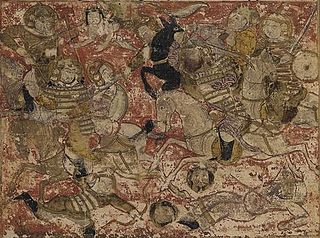
The Battle of Siffin was fought in 657 CE between the fourth Rashidun caliph Ali ibn Abi Talib and the rebellious governor of Syria Mu'awiya ibn Abi Sufyan. The battle is named after its location Siffin on the banks of the Euphrates. The fighting stopped after the Syrians called for arbitration to escape defeat, to which Ali agreed under pressure from some of his troops. The arbitration process ended inconclusively in 658 though it strengthened the Syrians' support for Mu'awiya and weakened the position of Ali. The battle is considered part of the First Fitna and a major step towards the establishment of the Umayyad Caliphate.
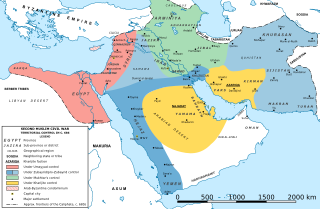
The Second Fitna was a period of general political and military disorder and civil war in the Islamic community during the early Umayyad Caliphate. It followed the death of the first Umayyad caliph Mu'awiya I in 680, and lasted for about twelve years. The war involved the suppression of two challenges to the Umayyad dynasty, the first by Husayn ibn Ali, as well as his supporters including Sulayman ibn Surad and Mukhtar al-Thaqafi who rallied for his revenge in Iraq, and the second by Abd Allah ibn al-Zubayr.
Cursing Ali was a state policy introduced by Mu'awiya ibn Abi Sufyan, the first Umayyad caliph, which mandated publicly cursing Ali ibn Abi Talib, the cousin and son-in-law of the Islamic prophet Muhammad, who was also the fourth Rashidun caliph and the first Shia Imam. Mu'awiya was the incumbent governor of Syria who had rebelled against Ali ostensibly to avenge the previous caliph Uthman, who was in turn assassinated by some provincial dissidents angered by his policies. Ali and Mu'awiya fought the inconclusive Battle of Siffin in 657 CE and remained enemies until the assassination of Ali in 661, which paved the way for the caliphate of Mu'awiya in the same year. The public cursing of Ali continued after Mu'awiya and was finally abandoned some sixty years later by the pious Umar II. The policy likely served as a propaganda measure, and also helped provoke, identify, and then crush the supporters of Ali, whom the Umayyads considered a threat.
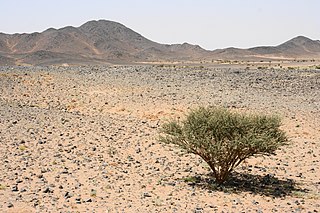
The Battle of al-Harra was fought between the Umayyad army of the caliph Yazid I led by Muslim ibn Uqba and the defenders of Medina from the Ansar and Muhajirun factions, who had rebelled against the caliph. The battle took place at the lava field of Harrat Waqim in the northeastern outskirts of Medina on 26 August 683 and lasted less than a day.

The Battle of the Camel took place outside of Basra, Iraq, in 36 AH. The battle was fought between the army of the fourth caliph Ali, on one side, and the rebel army led by Aisha, Talha and Zubayr, on the other side. Ali was the cousin and son-in-law of the Islamic prophet Muhammad, while Aisha was a widow of Muhammad, of whom Talha and Zubayr were both prominent companions. Ali emerged victorious from the battle, Talha and Zubayr were both killed, and Aisha was sent back to Hejaz afterward. The triumvirate had revolted against Ali ostensibly to avenge the assassination of the third caliph Uthman, although Aisha and Talha are both known to have actively opposed him. The three also called for the removal of Ali from office and for a Qurayshite council (shura) with Talha and Zubayr to appoint his successor.
The Umayyad dynasty or Umayyads was an Arab clan within the Quraysh tribe who were the ruling family of the Caliphate between 661 and 750 and later of al-Andalus between 756 and 1031. In the pre-Islamic period, they were a prominent clan of the Meccan tribe of Quraysh, descended from Umayya ibn Abd Shams. Despite staunch opposition to the Islamic prophet Muhammad, the Umayyads embraced Islam before the latter's death in 632. Uthman, an early companion of Muhammad from the Umayyad clan, was the third Rashidun caliph, ruling in 644–656, while other members held various governorships. One of these governors, Mu'awiya I of Syria, opposed Caliph Ali in the First Muslim Civil War (656–661) and afterward founded the Umayyad Caliphate with its capital in Damascus. This marked the beginning of the Umayyad dynasty, the first hereditary dynasty in the history of Islam, and the only one to rule over the entire Islamic world of its time.
Sa'id ibn al-As ibn Abi Uhayha was the Muslim governor of Kufa under Caliph Uthman and governor of Medina under Caliph Mu'awiya I. Like the aforementioned caliphs, Sa'id belonged to the Umayyad clan of the Quraysh.
Sa'id ibn Uthman ibn Affan al-Umawi was an Umayyad general and military governor of Khurasan in 676–677 during the reign of Caliph Mu'awiya I. He was a son of Caliph Uthman and a one-time seeker of the caliphate in 675/76.
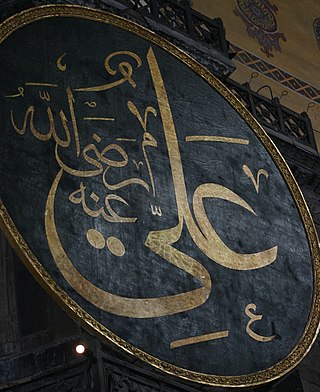
Ali ibn Abi Talib was acclaimed in 656 CE as the fourth caliph after the death of the Islamic prophet Muhammad. Following the 656 assassination of the third caliph Uthman in Medina by provincial rebels who had grievances about injustice and corruption, the prophet's cousin and son-in-law was elected to the caliphate by the rebels, the Ansar, and the Muhajirun. While the election of Ali faced little opposition, his support was limited among the Quraysh, some of whom aspired to the caliphate. The Umayyads and some others thereby left Medina––some thus breaking their oaths of allegiance––and soon rebelled against Ali.

The Uthmaniyya were adherents of several political and doctrinal views regarding the third caliph, Uthman, which originated in the aftermath of his assassination in 656. The earliest Uthmaniyya held that Uthman was legitimate caliph and his murder was unjust, whereas his successor, Ali, having been complicit in the act, was an illegitimate caliph who seized power without consultation. Although not all of them were Umayyad supporters, they undermined Ali's caliphate through several revolts. In the 8th century, pro-Uthman opinion gained momentum among religious scholars, who considered only Abu Bakr, Umar, and Uthman as legitimate caliphs, but discouraged rebellion against authorities, preferring peace and unity over morally correct caliphs. They were absorbed by the Sunnis in the 9th century, when both Uthman and Ali were recognized as rashidun ('rightly-guided') caliphs. Although strongly pro-Umayyad Uthmaniyya persisted for some time, they virtually disappeared after the 10th century.

The second Syria campaign of Ali refers to the abortive efforts of Ali ibn Abi Talib, the Muslim caliph and the first Shia Imam, to organize a renewed military campaign against Mu'awiya, the rebellious governor of Syria. Following the indecisive Battle of Siffin against Mu'awiya in 657 CE, Ali subdued the Kharijites revolt in the Battle of Nahrawan in 658, but his military coalition in Iraq collapsed afterward when the tribal chiefs withdrew their support, as they hoped for peace with Mu'awiya on beneficial terms. Ali henceforth could barely muster enough force to repel the frequent raiding parties dispatched by Mu'awiya to harass the civilian population loyal to Ali. Egypt too fell to Mu'awiya in 658, further limiting the influence of Ali outside of Iraq. Following the raid of Busr ibn Abi Artat in 661, however, the public outrage against Mu'awiya finally seems to have galvanized the Iraqis' support for war, and a large offensive was planned for the late winter. These plans were abandoned after the assassination of Ali by the Kharijite Ibn Muljam on 26 January 661, during the morning prayers. His assassination paved the way for Mu'awiya, who later founded the Umayyad Caliphate.













